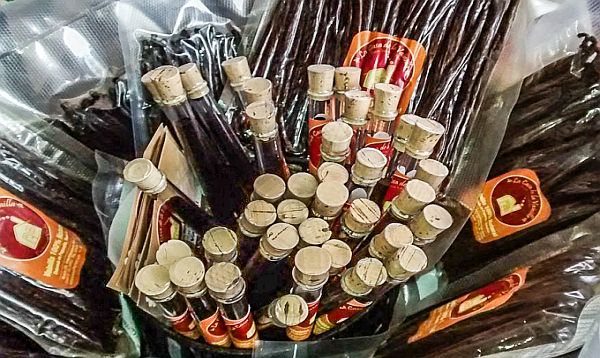
Puerto Vallarta, Mexico – Vanilla beans cultivated around the world originally all came from Mexico. When Cortés came to conquer Mexico in 1519, he sent samples of the vanilla orchid back to Spain where they eventually spread to other growing areas around the world including Madagascar, Indonesia, Reunion (at the time called “Il de Bourbon”), Tonga, Costa Rica, & Papua New Guinea.
There are several distinct species of the vanilla orchid, the most common being Vanilla planifolia, Vanilla tahitiensis (a Mexican hybrid), and Vanilla pompona.
Vanilla extract is usually marketed as “Bourbon vanilla,” most of which is grown in Indonesia and Madagascar. It comes from the same species (Vanilla planiolia) grown in Mexico, which is called “Mexican vanilla,” purely a marketing designation. The difference between the two is mostly in the processing of the Vanilla beans after harvesting.
Some of the vanilla extracts sold in Mexico are stretched with tonka bean extract, which has a similar taste and aroma to vanilla but contains coumarin which can be toxic to the liver and is banned as a food additive by the US Food & Drug Administration since the 1950s. Most reputable companies avoid this additive. Other countries have less strict regulations.
Pure Vanilla Extract has a complex flavor, comprised of approximately 300 individual flavor components all working together to create its rich flavor and bouquet. Producing premium pure vanilla extract always begins with the beans. You cannot produce high quality extracts with inferior quality beans! It can be found in several strengths called fold: single (1X) and double (2X) are common for the baking industry. There is even a 60X strength available only to industrial users where excessive liquid is a problem.

Pure Mexican Vanilla has at least a 35% alcohol content and higher natural vanillin concentration. It is therefore best utilized in those items which require high heat, such as baked goods. This allows much of the alcohol to burn off. The color is light brown from the cured beans. Although expensive, this is the BEST vanilla you can buy in Mexico.
Traditional Mexican Vanilla has 10% alcohol (90% water) and less than 1% of natural vanillin. The vanillin helps hold the flavor. Also the less alcohol makes the vanilla much more versatile and can be used for anything that calls for vanilla such as French toast, smoothies, homemade ice cream, whip cream, cookies, cakes, oatmeal, etc.
Artificial Vanilla Extract In the 1880s the first synthetic vanilla extracts came from Germany, providing a cheaper alternative to natural vanilla. Soon it was discovered that synthetic vanillin could be made from the waste water of paper pulp and coal tar processing. Mexico, Central America, and the Caribbean began selling cheap synthetic vanillas hoping to cash in on Mexico’s vanilla connection.
LABELING
There are numerous words used to label “vanilla” sold in stores today. BEWARE! The cheap product in the big bottle is not vanilla at all. It is imitation vanilla with unknown ingredients. Make sure the brown bottle doesn’t contain clear “vanilla” liquid.
Natural and Artificial Vanillas are a blend of natural vanilla fortified with artificial vanillin, flavors and other “ingredients.”
Clear vanilla is artificial vanillin. It’s often called “crystal vanilla.”
Dark and murky is synthetic vanillin, most likely ethyl vanillin derived from coal tar. It may also be dark because it contains red dye or caramel (carmelo) coloring.
PRODUCTION PROCESS
Another clue to finding good quality vanilla extract is the price. Vanilla is the second most expensive “food flavoring” after saffron. This is due mainly to the labor-intensive growing and curing processes.

Quality vanilla beans come when the vine is grown on rich soil using good farming practices (not crowding the vines, water/moist environment and the right amount of shade/sun). The flower that produces the bean only appears for one day and in most countries has to be hand-pollinated. The most important part of the process is WHEN to cut the bean from the vine. This has to be done bean by bean when yellow at the tip indicates a fully matured bean with the highest concentration (2%+) of vanillin inside.
First, the pods are heated (the “Bourbon Process”) to stop growth, to prevent sugar from turning to starch and to break down the cell walls. The “Mexican Process” is to place the beans in the hot sun, then wrapping them in a blanket overnight to keep them warm. This process of exposure to daily sun then wrapping in cloth is repeated for up to six weeks. This stage develops vanillin, the main flavor component.
The next step is the drying/curing process. If the bean has been cut when yellow at the tip, the process of curing will be shorter. Additionally, there will be very little loss due to mold which occurs more often when the beans are cut “green” instead of when yellow at the tip. Drying and curing go together.
Then comes maturation in boxes which straightens the pods to further enhance the flavor. It is in this last stage that Mexican vanilla differs most significantly. Whereas vanilla from Madagascar may cure for about 5 weeks, Mexican vanilla will cure for up to nine months. Beans are graded for quality and are then ready for the extraction phase.
The cured beans are ground and then exposed to heat and pressure to extract the vanilla into an alcohol solution. Some companies are experimenting with a cold extraction process that they claim preserves the nutrients and rich flavors better than using heat. At this point, the extracted liquid is ready for bottling.

Note: Gracias to T.J. Hartung, Puerto Vallarta orchid specialist, for editorial help.
Sandra Cesca has traveled the world, but found herself returning to Mexico more and more. She moved to Puerto Vallarta in 2008 and never looked back. She currently offers eight different Puerto Vallarta Walking Tours, which include history, architecture, culture, artisanal crafts and ecology. Her photos and articles can be found on puertovallartawalkingtours.com; yourculturalinsider.com; sandracescaphotography.com; Instagram and Facebook. She can be contacted at sandra.learn.vallarta(at)gmail.com; or sandra.cesca.photography(at)gmail.com.




